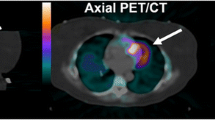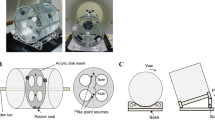Abstract
Objective
Various motion correction (MC) algorithms for positron emission tomography (PET) have been proposed to accelerate the diagnostic performance and research in brain activity and neurology. We have incorporated MC system-based optical motion tracking into the brain-dedicated time-of-flight PET scanner. In this study, we evaluate the performance characteristics of the developed PET scanner when performing MC in accordance with the standards and guidelines for the brain PET scanner.
Methods
We evaluate the spatial resolution, scatter fraction, count rate characteristics, sensitivity, and image quality of PET images. The MC evaluation is measured in terms of the spatial resolution and image quality that affect movement.
Results
In the basic performance evaluation, the average spatial resolution by iterative reconstruction was 2.2 mm at 10 mm offset position. The measured peak noise equivalent count rate was 38.0 kcps at 16.7 kBq/mL. The scatter fraction and system sensitivity were 43.9% and 22.4 cps/(Bq/mL), respectively. The image contrast recovery was between 43.2% (10 mm sphere) and 72.0% (37 mm sphere). In the MC performance evaluation, the average spatial resolution was 2.7 mm at 10 mm offset position, when the phantom stage with the point source translates to ± 15 mm along the y-axis. The image contrast recovery was between 34.2 % (10 mm sphere) and 66.8 % (37 mm sphere).
Conclusions
The reconstructed images using MC were restored to their nearly identical state as those at rest. Therefore, it is concluded that this scanner can observe more natural brain activity.



source placements for the MC evaluation in spatial resolution measurement (A axial view and B coronal view). The point source was placed on a hollow phantom with retro-reflective markers to assume the measurement of the human head




Similar content being viewed by others
References
Meikle SR, Sossi V, Roncali E, Cherry SR, Banati R, Mankoff D, et al. Quantitative PET in the 2020s: a roadmap. Phys Med Biol. 2021;66:06RM01.
Watanabe M, Shimizu K, Omura T, Takahashi M, Kosugi T, Yoshikawa E, et al. A new high-resolution PET scanner dedicated to brain research. IEEE Trans Nucl Sci. 2002;49:634–9.
Yamamoto S, Honda M, Oohashi T, Shimizu K, Senda M. Development of a brain PET system, PET-Hat: a wearable PET system for brain research. IEEE Trans Nucl Sci. 2011;58:668–73.
Jung J, Choi Y, Jung JH, Kim S, Im KC. Performance evaluation of neuro-PET using silicon photomultipliers. Nucl Instrum Methods A. 2016;819:182–7.
Tashima H, Yoshida E, Iwao Y, Wakizaka H, Maeda T, Seki C, et al. First prototyping of a dedicated PET system with the hemisphere detector arrangement. Phys Med Biol. 2019;64: 065004.
Moliner L, Rodríguez-Alvarez MJ, Catret JV, González A, Ilisie V, Benlloch JM. NEMA performance evaluation of CareMiBrain dedicated brain PET and comparison with the whole-body and dedicated brain PET systems. Sci Rep. 2019;9:15484.
Wienhard K, Schmand M, Casey ME, Baker K, Bao J, Eriksson L, et al. The ECAT HRRT: performance and first clinical application of the new high resolution research tomograph. IEEE Trans Nucl Sci. 2002;49:104–10.
Yoshida E, Kobayashi A, Yamaya T, Watanabe M, Nishikido F, Kitamura K, et al. The jPET-D4: Performance evaluation of four-layer DOI-PET scanner using the NEMA NU2-2001 standard. In: 2006 IEEE nuclear science symposium and medical imaging conference. 2006:2532–6.
Gong K, Majewski S, Kinahan PE, Harrison RL, Elston BF, Manjeshwar R, et al. Designing a compact high performance brain PET scanner–simulation study. Phys Med Biol. 2016;61:3681–97.
Watanabe M, Saito A, Isobe T, Ote K, Yamada R, Moriya T, et al. Performance evaluation of a high- resolution brain PET scanner using four-layer MPPC DOI detectors. Phys Med Biol. 2017;62:7148–66.
Akamatsu G, Tashima H, Iwao Y, Wakizaka H, Maeda T, Mohammadi A, et al. T. performance evaluation of a whole-body prototype PET scanner with four-layer DOI detectors. Phys Med Biol. 2019;64:095014.
Sluis J, Jong J, Schaar J, Noordzij W, Snick P, Dierckx R, et al. Performance characteristics of the digital biograph vision PET/CT System. J Nucl Med. 2019;60:1031–6.
Yoshida E, Tashima H, Akamatsu G, Iwao Y, Takahashi M, Yamashita T, et al. 245 ps-TOF brain-dedicated PET prototype with a hemispherical detector arrangement. Phys Med Biol. 2020;65: 145008.
Vandenberghe S, Mikhaylova E, D’Hoe E, Mollet P, Karp JS. Recent developments in time-of-flight PET. EJNMMI Phys. 2016;3:3.
Surti S, Karp JS. Update on latest advances in time-of-flight PET. Phys Med. 2020;80:251–8.
Kwon SI, Ota R, Berg E, Hashimoto F, Nakajima K, Ogawa I, et al. Ultrafast timing enables reconstruction-free positron emission imaging. Nat Photon. 2021;15:914–8.
Rahmin A, Rousset O, Zaidi H. Strategies for motion tracking and correction in PET. PET Clin. 2007;2:251–66.
Herzog H, Tellmann L, Fulton R, Stangier I, Kops ER, Bente K, et al. Motion artifact reduction on parametric PET images of neuroreceptor binding. J Nucl Med. 2005;46:1059–65.
Zaidi H, Montandon M, Meikle S. Strategies for attenuation compensation in neurological PET studies. Neuroimage. 2006;34:518–41.
Inubushi T, Ito M, Mori Y, Futatsubashi M, Sato K, Ito S, et al. Neural correlates of head restraint: unsolicited neuronal activation and dopamine release. Neuroimage. 2021;224: 117434.
Kyme AZ, Fulton RR. Motion estimation and correction in SPECT. PET and CT Phys Med Biol. 2021;66:18TR02.
Keller SH, Sibomana M, Olesen OV, Svarer C, Holm S, Andersen FL, et al. Methods for motion correction evaluation using 18F-FDG human brain scans on a high-resolution PET scanner. J Nucl Med. 2012;53:495–504.
Noonan PJ, Howard J, Hallett WA, Gunn RN. Repurposing the microsoft kinect for windows v2 for external head motion tracking for brain PET. Phys Med Biol. 2015;60:8753–66.
Iwao Y, Akamatsu G, Tashima H, Takahashi M, Yamaya T. Marker-less and calibration-less motion correction method for brain PET. Radiol Phys Technol. 2022;5:125–34.
Picard Y, Thompson CJ. Motion correction of PET images using multiple acquisition frames. IEEE Trans Med Imag. 1997;16:137–44.
Slipsager JM, Ellegaard AH, Glimberg SL, Paulsen RR, Tisdall MD, Wighton P, et al. Markerless motion tracking and correction for PET, MRI, and simultaneous PET/MRI. PLOS One. 2019;14: 0215524.
Rakvongthai Y, Fakhri GE. Magnetic resonance-based motion correction for quantitative PET in simultaneous PET-MR Imaging. PET Clin. 2017;12:321–7.
Saito A, Yoshikawa E, Omura T, Yamanaka T, Ote K, Isobe T, et al. Development of a brain PET scanner with motion correction using motion capture technology. IEEE Nuclear Science Symposium and Medical Imaging Conference. 2018:M-07-146.
Akamatsu G, Tashima H, Yoshida E, Wakizaka H, Iwao Y, Maeda T, et al. Modified NEMA NU-2 performance evaluation methods for a brain-dedicated PET system with a hemispherical detector arrangement. Biomed Phys Eng Express. 2019;6: 015012.
Industries Association of Radiation Apparatus (JESRA): Performance evaluation of positron emission tomographs X-0073*G-2019: 2019
Ota R. Photon counting detectors and their applications ranging from particle physics experiments to environmental radiation monitoring and medical imaging. Radiol Phys Technol. 2021;14:134–48.
Yamaya T, Inaniwa T, Minohara S, Yoshida E, Inadama N, Nishikido F, et al. A proposal of an open PET geometry. Phys Med Biol. 2008;53:757–73.
Zhang Z. A flexible new technique for camera calibration. IEEE Trans Pattern Anal Mach Intell. 2000;12:1330–4.
Tanaka E, Kudo H. Optimal relaxation parameters of DRAMA (Dynamic RAMLA) aiming at one-pass image reconstruction for 3D-PET. Phys Med Biol. 2010;55:2917–39.
Badawi RD, Marsden PK. Developments in component-based normalization for 3D PET. Phys Med Biol. 1999;44:571–94.
Zaidi H, Hasegawa B. Determination of the attenuation map in emission tomography. J Nucl Med. 2003;44:291–315.
Watson C. New, faster, image-based scatter correction for 3D PET. IEEE Trans Nucl Sci. 2000;47:1587–94.
Rahmim A, Lenox M, Reader AJ, Michel C, Burbar Z, Ruth TJ, et al. Statistical list-mode image reconstruction for the high resolution research tomograph. Phys Med Biol. 2004;49:4239–58.
Jin X, Mulnix T, Gallezot J, Carson RE. Evaluation of motion correction methods in human brain PET imaging–A simulation study based on human motion data. Med Phys. 2013;40: 102503.
Iwao Y, Tashima H, Yoshida E, Nishikido F, Ida T, Yamaya T. Seated versus supine: consideration of the optimum measurement posture for brain-dedicated PET. Phys Med Biol. 2019;64: 125003.
Zein SA, Karakatsanis NA, Conti M, Nehmeh SA. Monte Carlo simulation of the siemens biograph vision PET with extended axial field of view using sparse detector module rings configuration. IEEE Trans Radiat Plasma Med Sci. 2021;5:331–42.
Lehnert W, Riss PJ, Mendoza A, Lopez S, Fernandez G, Ilheu M, et al. Whole-body biodistribution and radiation dosimetry of [18 F] PR04.MZ: a new PET radiotracer for clinical management of patients with movement disorders. EJNMMI Res. 2022;12:1.
Hoffman M, Bezrukov I, Mantlik F, Aschoff P, Steinke F, Bayer T, et al. MRI-based attenuation correction for whole-body PET/MRI: quantitative evaluation of segmentation- and atlas-based methods. J Nucl Med. 2011;9:1392–9.
Rezaei A, Defrise M, Bal G, Michel C, Conti M, Watson C, et al. Simultaneous reconstruction of activity and attenuation in time-of-flight PET. IEEE Trans Med Imag. 2012;12:2224–33.
Hashimoto F, Ito M, Ote K, Isobe T, Okada H, Ouchi Y. Deep learning-based attenuation correction for brain PET with various radiotracers. Ann Nucl Med. 2021;6:691–701.
Acknowledgements
The authors would like to thank the following people for their scientific advice and technical assistance, in alphabetical order: Akihiro Kakimoto, Akinori Saito, Kibo Ote, Mineo Egawa, Mitsuo Watanabe, Ryosuke Ota, and Takahiro Moriya. We are grateful to Aki Sato, Hatsumi Takahashi, Hiroyuki Okada, Kyoji Matsuyama, Nobutoshi Nakamura, Toru Hirohata, and Yutaka Yamashita for administrative assistance. The authors gratefully acknowledge the staff of Hamamatsu Medical Imaging Center, Hamamatsu Medical Photonics Foundation, for providing technical assistance.
Author information
Authors and Affiliations
Corresponding author
Ethics declarations
Conflict of interest
Y.O., T.I., M.I., F.H., T.O., and E.Y. are employees of Hamamatsu Photonics K.K. The company had no control over the interpretation, writing, or publication of this work.
Additional information
Publisher's Note
Springer Nature remains neutral with regard to jurisdictional claims in published maps and institutional affiliations.
Rights and permissions
About this article
Cite this article
Onishi, Y., Isobe, T., Ito, M. et al. Performance evaluation of dedicated brain PET scanner with motion correction system. Ann Nucl Med 36, 746–755 (2022). https://doi.org/10.1007/s12149-022-01757-1
Received:
Accepted:
Published:
Issue Date:
DOI: https://doi.org/10.1007/s12149-022-01757-1




